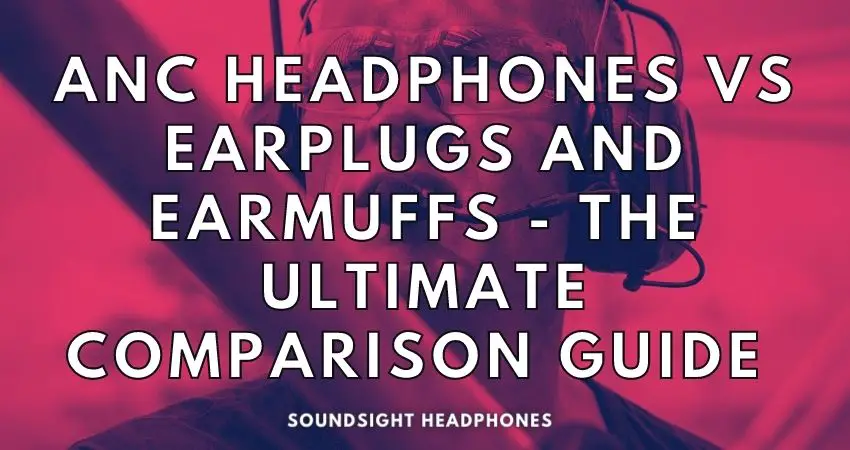Noise-canceling headphones, earmuffs, and earplugs are a great way to eliminate noise distractions. They protect your eardrums from damage caused by prolonged exposure to loud sounds. Interested in knowing what type of noise-canceling headphones are best for you? If you should use earmuffs or earplugs? Or which hearing protection device offers the best protection against noise? You’ve come to the right place!
This article provides a comprehensive comparison guide to help you choose the best isolation device between headphones, earmuffs, and earplugs, including the pros and cons, unique features of each type of hearing protection. Also included in this comprehensive article are explanations of the different concepts and a list of frequently asked questions (FAQs).
- Active noise-canceling headphones—Stereo headphones for noise reduction
- Earplugs & earmuffs – Anatomy and differences between earplugs and earmuffs
- About noise reduction ratings (NRR) – What is NRR?
- The best noise isolating headphones (ANC vs. earmuffs vs. earplugs)
- Simultaneous use of earmuffs and earplugs or ANC earbuds
- FAQ regarding the best noise-isolating headphones
- What are the best devices for noise isolation?
- Are active noise-canceling headphones good for noise isolation?
- Should I use earplugs with active noise-canceling headphones?
- Does the simultaneous use of earmuffs and earplugs improve sound insulation?
- Is there a difference between NRR, SNR, SNRA, and NRR?
- What is the difference between headphones, earplugs, and earmuffs?
- Conclusion
Active noise-canceling headphones—Stereo headphones for noise reduction
What are active noise-canceling headphones
Active Noise Cancelling (ANC) headphones are typically used for entertainment and additional noise reduction in noisy areas such as airports, public transportation, offices, and busy downtown New York venues. They are closed-back headphones that fit over your ears and create a seal to prevent noise from entering your ear canal. ANC headphones provide active and passive noise attenuation through materials and other sound-isolating features.
Advantages and disadvantages of using active noise cancellation headphones versus earmuffs and earplugs
When it comes to the pros and cons of active noise cancellation technology, there are a lot of details that many people don’t know. But when it comes to comparing active noise-canceling headphones to headphones and earplugs, some aspects stand out more than others. LINK HERE
Unlike earmuffs and earplugs, active noise-canceling headphones have the following qualities:
- You can listen to music with them.
- They are more stylish and can be used as a fashion statement.
- They have additional technologies, microphones for hands-free conversations, and convenient features such as “transparent listening mode” or voice assistant.
As such, these are the most significant advantages of ANC headsets over earmuffs and earplugs. Moreover, ANC headsets are more user-friendly and can be used on the road or at work, whereas ear muffs are a bit rudimentary for such environments.
Nevertheless, when comparing ANC headphones to earmuffs and earplugs, it’s hard to ignore their drawbacks:
- ANC headphones are not as comfortable to wear as earmuffs and earplugs.
- They are more expensive
- Noise reduction is not consistent.
- Noise cancellation depends on battery life
- Whistling and buzzing audible when ANC is activated without music or low volume.
- Unlike earmuffs, most ANC headphones cannot be used without music
Ultimately, ANC headphones are sophisticated entertainment devices for music listening and share earmuffs and earplugs’ hearing protection properties. Still, they are also more expensive, less comfortable to wear, require batteries, and have limitations.
Despite their limitations, ANC headsets can reduce various noises to a large extent and provide a fantastic listening experience. LINK HERE
Most practical use cases for active noise-canceling headphones
Active noise-canceling headphones can be used in various ways, from sports and outdoor activities to the workplace, gaming, and traveling. More importantly, they have become a popular tool among general consumers for transportation, commuting, and studying.
Headphones with ANC can be used for the following:
- Enjoy music in noisy environments
- Reduce the noise of public transportation
- Increase productivity at work or school
- Improve personal audio quality while gaming
- Reduce background noise while studying or working out
- Protect hearing and prevent tinnitus
The importance of active noise-canceling headphones in our daily lives is better explained in an article I recently wrote. In short, active noise-canceling headphones are versatile and can be used in many environments with great results.
How much noise reduction do ANC headphones provide
Active Noise Cancelling headphones significantly reduce background noise depending on how they are used, the noise-canceling technology, and whether the ANC feature is adjustable and at maximum efficiency. LINK HERE
- ANC off: When used as a regular headset (without the active noise cancellation), ambient sounds are reduced by 15-20 dB.
- ANC on: With the active noise cancellation on, ambient sounds are attenuated by 20 to 25 dB due to a greater reduction in the low-frequency range.
The following graph shows the difference in attenuation between normal headphones and headphones with active noise cancellation:
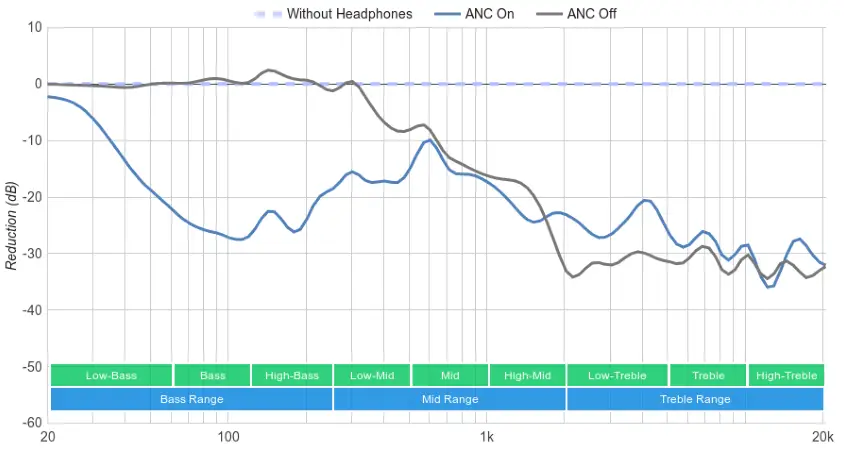
Tip: To use active noise-canceling headphones without music, the “ANC on” curve should not be above the “ANC off” curve (passive noise reduction).
Earplugs & earmuffs – Anatomy and differences between earplugs and earmuffs
The two types of hearing protection, earplugs, and earmuffs, can be placed in the same category because they both protect against noise and do not allow music to be played. The only difference is in how they do it, namely the type of design and the material they are made of.
The difference between earplugs and earmuffs is that earplugs are placed inside the ear canal, while earmuffs are similar to over-the-ear headphones and completely cover your ears. Both have a similar noise reduction rating, but in the case of earplugs, it depends on the fit.
Earplugs have the following characteristics:
- Earplugs are made of a soft rubber or foam material with a hollow center.
- Earplugs are either custom-made or pre-assembled by the manufacturer.
- They are compact and are best used for sleeping and daytime hearing protection
- Provide an average noise reduction of -25 dB.
Earmuff features:
- Earmuffs protect the ears by going over the outer ear and providing a seal to block out noise.
- They have a high noise reduction rating and are used on the field.
- They are more hygienic because they do not stick in the ear constantly.
Earplugs are intended for noise protection and occasional use.
Earplugs are used to prevent sound waves from entering the ear through the outer part of the ear canal. They are small and have a soft, flexible stem that can be inserted into the ear canal. Some earplugs are used for sleeping, to protect hearing, and others are designed for concerts or commuters who want to avoid hearing loss when passing noisy work sites or traffic.
Some earplugs can be used for more personal reasons, such as warmth or protection from dust and noise. They are small and light and can be easily carried without extra weight. Plus, they provide massive protection against harsh noises.
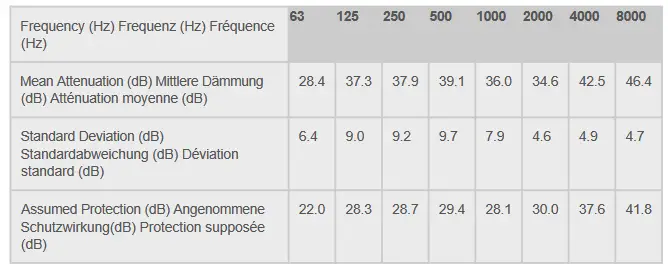
Main use of earplugs
You can use earplugs anywhere you like. However, there are a few main uses for which they are best suited:
- Sleeping & napping
- Concert-goers, musicians, sound engineers
- Working out in a gym
- Hearing protection on the way to work
- Passive protection from loud noises (like a jackhammer)
- Protection from dust and sand
- Quieter environment for studying
Earmuffs are more professional hearing aids intended for use in the field.
Earmuffs are larger, and some models can be fit on any head size. Unlike earplugs, earmuffs are connected by a headband, just as active noise-canceling headphones.
Main use of earmuffs
Earmuffs are designed to provide hearing protection in the field of work and can be found at a number of sites. Construction sites, shooting ranges, railroad workers, inspectors, and others who need to protect their ears while working will use earmuffs.
Earmuffs can be used in the following situations:
- Construction site employees
- Military and firing ranges
- Aviators and airline pilots
- Woodworkers and woodcutters
- Welders and metalworkers
- Sportsmen and hunters
- Near construction machinery and factory equipment
About noise reduction ratings (NRR) – What is NRR?
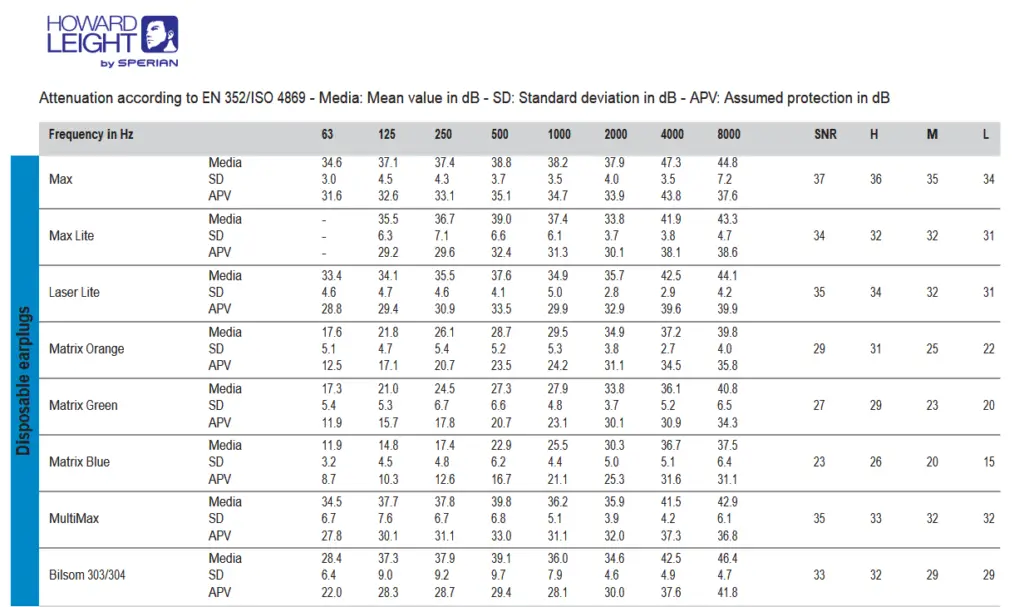
U.S. hearing protectors have a Noise Reduction Rating (NRR) listed on the package, which measures how much sound they block. The noise reduction rating is the average number of decibels (dB) that the hearing protection device reduces, resulting from three measurements across eight frequency bands.
Earplugs and earmuffs usually display an NRR label along with a table of noise attenuation in decibels for various frequencies. The labeling requirements and the exact method of measuring the attenuation must comply with the latest ANSI/ASA S12.6-2016 (R2020). EPA 40 CFR Part 211, Subpart B – Hearing Protective Devices, and ANSI S12.6-2016 specify the performance requirements and measurement methods for hearing protection devices’ noise reduction rating (NRR).
Different countries have different standards or naming conventions for hearing protection devices. All European Union countries adopt the ISO 4869-1 test standard and the SNR (Single Number Rating) rating. At the same time, Canadian hearing protection measurements are based on the CSA Z94.2 test standard and labels such as A, B, or C.
Issues with NRR labeling
The NRR is a reliable way to indicate the degree of protection of an earplug or hearing protection. It is calculated as an average of several tests over a range of frequencies. But it’s not everything, as other factors, such as fit, must be considered to achieve better performance.
When it comes to user experience, comfort and style are also two aspects that should be taken into account. Some users may be uncomfortable wearing earplugs and earmuffs for prolonged periods, which significantly reduces the comfort level of the product. As such, the best earplugs are the ones custom-made; these are more expensive but offer greater results.
Regardless of the NRR, construction workers and anyone else who needs hearing protection on the job receive training and guidance on the best devices to use. A poor fit may offer no noise protection or ineffective noise reduction. So far, a high NRR is only a requirement, but noise reduction depends on ear morphology, not theoretical values. The size and fit of the earplugs are most important here.
NRR is a relatively subjective and pragmatic value for earplugs. Earmuffs, on the other hand, have more reliable noise reduction ratings. Although, they also depend on fit and seal to provide the best sound isolation.
The best noise isolating headphones (ANC vs. earmuffs vs. earplugs)
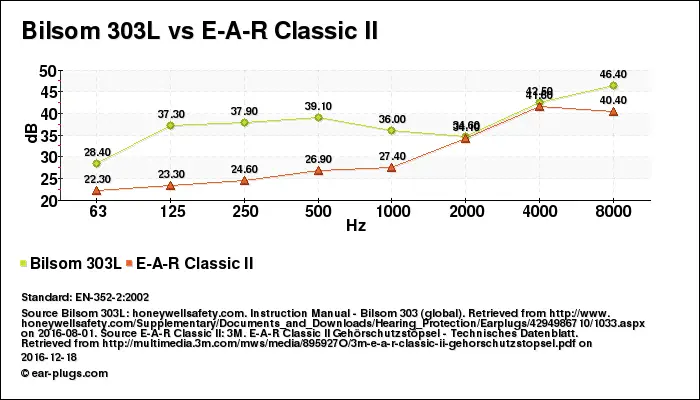
Hearing protection does not always have to be in the form of earplugs or earmuffs but can also be achieved with noise-canceling headphones. However, the best noise reduction is achieved with earmuffs and earplugs. These provide up to 35 dB of noise reduction across the audio spectrum (35 NRR), reducing low frequencies of 30 dB or more and more than 30 dB in the mid and high frequencies.
Bilsom 303L earplugs, for example, provide 33 NRR, with a noise reduction performance of -35 dB at 125, 250, 500, and 1000 Hz, which is almost double the number of decibels compared to active noise-canceling headphones. And considering the logarithmic scale of the dB scale, this is a significant amount.
An NRR of 30 or 35 in the 20 Hz – 1,000 Hz range is not uncommon for earmuffs and earplugs, while wireless headphones with active noise cancellation rarely offer this level of performance in the sub-bass region and near the 1,000 Hz mark.
The best active noise-canceling headphones offer up to -25 dB in the lower end of the audio spectrum in terms of noise reduction and 30-40 dB of sound isolation in the upper-end. As such, earmuffs and earplugs offer more consistent and much stronger sound isolation and better hearing protection for workers.
Active noise-canceling headphones are not suitable for use in a factory or construction site because the equipment is not the most reliable and consistent and relies on microphones and other electronics to generate the opposing sound waves. Ultimately, earmuffs and earplugs offer the best sound isolation properties.
Simultaneous use of earmuffs and earplugs or ANC earbuds
The simultaneous use of earmuffs and earplugs is a common practice. The effect is a pronounced reduction in noise and is necessary when the noise threshold in your workplace is above 100 dB.
Similarly, you can use a pair of active noise-canceling earbuds with strong low-frequency attenuation and combine them with earmuffs. Low frequencies are better attenuated with active noise cancellation, and high frequencies are better attenuated with earmuffs. The two devices create a perfect synergy for maximum protection against all types of noise.
FAQ regarding the best noise-isolating headphones
What are the best devices for noise isolation?
Custom earplugs are the best solution for noise isolation and offer a unique, comfortable, and stable fit. Some of the best earplugs for low-frequency noise can block up to 40 dB of noise in the bass range, which is exceptional compared to the best active noise-canceling headphones.
Earmuffs are the second-best device for noise isolation because they offer an equally high NRR (30-35 dB) in the low frequencies and are also lightweight, comfortable, and stable. But ear muffs are not discreet and cannot be casually in public.
ANC headphones are the third-best device for noise isolation. The best models offer 20-25 dB of noise attenuation in the low frequencies and up to 30-35 dB in the highs, with an average NRR of 25. The best part about noise-canceling headphones is their ability to play music and offer a variety of features, making them the best all-around hearing device for noise isolation.
Are active noise-canceling headphones good for noise isolation?
Yes and no. Compared to earplugs and earmuffs, active noise-canceling headphones are the worst devices in terms of noise reduction. However, they are well-rounded headphones for entertainment and are good enough for their intended purpose. Plus, they offer additional noise reduction over passive headphones.
Should I use earplugs with active noise-canceling headphones?
You can use earplugs when listening to music with ANC headphones, but this defeats the purpose of listening to music. Earplugs are designed to reduce the noise entering your ears and affect your music playback. Another way to combine two sets of headphones for better sound isolation is to use one pair of truly wireless headphones with ANC and the second pair of over-ear headphones or discreet earmuffs on top of them.
Does the simultaneous use of earmuffs and earplugs improve sound insulation?
Using earmuffs and earplugs simultaneously can slightly improve sound isolation, but the increase is not huge. It is common to use earplugs for low-frequency noise and add earmuffs to attenuate high frequencies. Workers in extremely loud industrial environments often wear earmuffs and earplugs together. It is also common to use custom earplugs with active noise-canceling (ANC) headphones, as long as you can use the active noise-canceling headphones without music. LINK HERE
Is there a difference between NRR, SNR, SNRA, and NRR?
No, they all have the same meaning. NRR is simply a noise attenuation rating indicating how much noise is reduced by wearing hearing protection. NRR stands for “Noise Reduction Rating” and measures subject-fit noise attenuation, expressed in average decibels (dB) obtained from multiple tests.
Americans use the word “NRR” while Europeans use the label “SNR.” Meanwhile, Brazil uses NRRsf, Canada uses A, B, or C, while Australia and New Zealand use SLC80.
What is the difference between headphones, earplugs, and earmuffs?
The biggest difference is that headphones are stereo devices that play music in two channels, while earplugs and earmuffs are designed solely to reduce noise levels.
Below are some other differences between earplugs, earmuffs, and headphones:
- Cost: Earplugs are much less expensive than earmuffs and headphones
- Shape and design: Headphones come in various designs; earbuds and earphones fit in your ears, while on-ear and over-the-ear headphones fit around or over your ears.
- Earplugs are made in different shapes and sizes; typical sizes used in the workplace range from 1 to 2 inches (ca. 5 cm), while earmuffs are similar to over-the-ear headphones but without the speakers
- Stereo headsets sometimes have hands-free features, remote controls, buttons, voice assistant, surround sound, etc., while earplugs and earmuffs do not
- Earplugs and earmuffs can be combined to create a more effective noise reduction system, but headphones cannot work with earplugs or earmuffs
- Some earplugs are for one-time use only
- Earmuffs are more robust and designed for more challenging circumstances, while headphones are designed with style and functionality in mind
- Some earmuffs have radio communication for smoother cooperation.
Conclusion
Noise-isolating headphones are a great way to tune out the outside world and enjoy a bit of peace and quiet. But they’re not all created equal. As shown in this article, ANC headphones, earplugs, and earmuffs all boast unique characteristics and features that make them worth considering.
